Have you ever wondered what might happen if you tried to take apart a Moleskine? I have… and recently, I actually tried it!
I had just started using a recently purchased Moleskine. As with most of the Moleskines I’ve been seeing in stores recently, I was annoyed that this notebook had a larger than usual cover overhang, but I didn’t notice in the store that the overhang was actually asymmetrical. The front cover seemed to have been pulled further around the spine than the back cover, so the front cover overhang was larger, and the spine was not quite square. The binding seemed a bit tight in general, and the notebook didn’t open quite as flat as usual. Below are a couple of “before” photos:
I know most people wouldn’t find these defects to be glaringly obvious, but they were grating on me more and more, and I actually wrote to Moleskine’s customer service about it (no response yet). The more I looked at the notebook, I wondered if I might be able to solve the problem by detaching the black outside cover from the inside front cover and re-gluing it. I picked at the inside front cover edges but they seemed very securely glued down. I thought about alternative ways of re-attaching the front cover– I’ve seen tutorials online where people slice the stiffer pages off of the inner page signatures in order to reload the notebook with different paper, but cutting the pages away from the inside cover wouldn’t have solved my problem, as I needed to reposition the inside cover itself. I also thought about cutting apart the inside cover, but worried it might sever the reinforcing tape that holds everything together, and weaken the whole binding. Glueing the two halves of the inside cover to each other might have helped, but then the notebook would open straight into the pages I’d already started writing on. I was pretty sure loosening the inside cover from the outer board was still the best option, if only I could figure out how to do it. Knowing that some glues can be loosened by heat, I decided to try blasting the notebook with a hair dryer for a while to see if that would soften the glue– and it actually worked! At least, sort of.
As you’ll see from the photos, I was able to successfully loosen most of the cover, but there were places where the glue was tight enough that the inside cover started to tear. Though I worked at it slowly and carefully with repeated use of the hair dryer, by the time I’d detached the front cover, I couldn’t avoid a big gash in the inside front cover where I just couldn’t get it loose.
At this point I was not too happy, as the inside front cover was all mangled and wrinkled and torn. But I was rather impressed at the resilience of the way the notebook was constructed! The next step was to re-glue the cover, repositioned so as to slightly loosen the spine and correct the uneven overhang. I spread wood glue, which was all I had, on the back of the inside cover, trying to avoid the hole. I was worried I’d end up having glue leak out and seal the whole inside front cover together, so I put some post-it notes in between and tried to make sure the glue was spread thinly and evenly. Then I carefully closed the cover, making sure everything was lined up right, and rubbed it to even out the glue and smooth any wrinkles. I wiped away any glue that came out at the edges. Then I left the notebook under some heavy books for about an hour, checking it a few times to make sure nothing was glued shut.
The result was better than expected– the cover is again attached securely and the mangled insides are pretty smoothed out. I tend to keep post-its in the inside front cover anyway, and they nicely camouflaged the mess I’d made. I may have slightly over-compensated on the cover positioning, as the overhang is now slightly less than it is on the back cover, but it’s more symmetrical than it was before, and overall, I am happy with the way I solved the problem. The notebook doesn’t seem weakened at all, and it opens flat, with the normal amount of give in the spine. If not for the tears, you’d never know anything had been done to it.
Unfortunately, I forgot to document the whole process with pictures and only remembered to grab my phone for some panicked shots after I’d already started to apply the glue! I was reminded of similar notebook-doctoring I’d done as a kid– I’d get obsessed with changing something about a notebook, then start working on it and realize I’d made a mistake. Then I’d have a horrible, anxious feeling of dismay because I’d destroyed an adored notebook instead of leaving well enough alone. And back then, it might be a few weeks before I could save up my allowance and buy another notebook. This time, I had the same feelings of stress while doing the surgery, unsure of whether the patient would make it through, though I at least knew I had plenty of other notebooks and enough money to buy more. It was a relief that it all turned out okay, though. Dissecting a Moleskine was an interesting experience, but I hope not to have to repeat it!

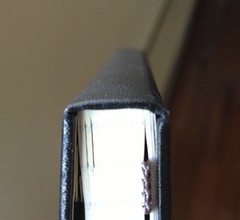

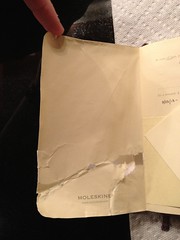
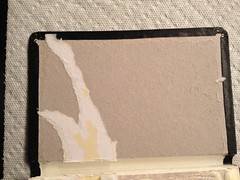
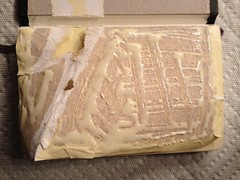
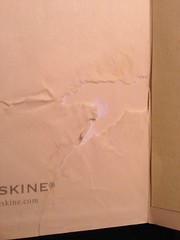
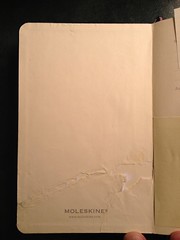

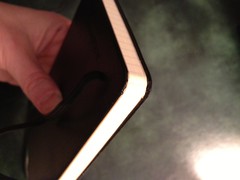
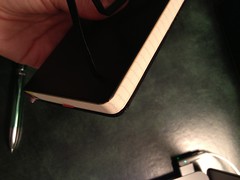
I quit using Moleskine a couple of years agowhen their quality seemed amazingly variable. I flirted with other brands. Although Rhodia re not easy to get in rural England their quality has never let me down, For me, the ultimate notebook is the Midori Traveler in both regular and passport size. Yes! It is an expensive option but it still has the fun element that has been so lacking since moleskinerie went corporate. A big product range may be the way to go, but Moly will go there without me!
I recently did a bit of Moleskine dissection myself in this post, ‘Weighing in on Moleskine paper’ (http://jusido.com/2013/03/26/weigh-moleskine-paper/).
It was more numerical and analytical than surgical, although there was some cutting-out of a signature and snipping of threads, etc. My motivation was also different, but I think we shared the same interest in and attention to detail. As I said in the post, I love the sketchbooks and storyboard notebooks, but the classic notebooks leave me — and my fountain pens — seriously wanting.
I was hesitant to join the Moleskine bandwagon, but do see the comfort of these little notebooks… What I don’t like is that the cover is too big for the pages, whereas the older version used to fit perfectly and you could feel the edges of the page… I think that’s called cover overhang(?)
I recently purchased two pocket notebooks like these, one in black and the other in red. (I’ve also seen them sold in white, green, purple, and dark pink in a local bookstore). I look at all of them and try to find one that has a cover closest to the edges of the pages… and also, if you choose one that has the lightest lines on the edge they are less noticable than those dark lines and squares that a lot of people are disconcerted by.
I am tempted to find a pink pocket moleskine with lines or squared, but have only seen them with plain paper.
Moleskine has tanked. Rhodia is where it’s at.
Moleskines all have flaws…it’s sad..remember when they used to be inspected?